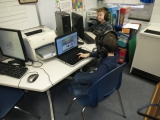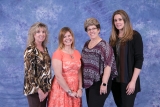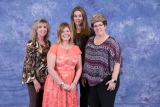-
Category 2
Selected in 2016
-
Grades: pre k - 3
School Setting: rural
Town Population: 1,386
Student Enrollment: 534
Student Demographics:
Black/African American: 19%
Teacher/Student Ratio: 1:14
White/Caucasian: 72.3%
Hispanic: 5%
Hawaiian/Pacific Islander: 0%
Asian: 0.6%
Native American: 0.2%
Other: 2.8%
% Reduced Lunch: 42.7%
% ELL Learners: 1%
Founded: 1969 -
PRINCIPAL:
Alexis Ray -
CONTACT:
319 East Main St
Felton, DE 19943
302-284-9611
alexis.ray@lf.k12.de.us
Lake Forest North Elementary School
Felton, DE
We strive to provide educational experiences that challenge and encourage every child to develop academically, emotionally, physically, socially, and culturally. Our culture of inclusivity and high expectations for all make North successful!
- Describe specific programs in place to ensure that families are involved in the success of your school and students.
- Family involvement is an integral part of our success at North. We provide families multiple opportunities to come into the school. This starts with our PTO and extends out to include all families. Our PTO provides teachers with “mini grants” that allow them to purchase instructional resources for their classrooms. They are also a key part of the school community by helping fund various school infrastructure improvements. Parents are also active members of our School Improvement and Positive Behavior Support committees. By being a part of these committees the parents are well versed in our school data and play an integral part in providing input and feedback on student achievement. Our Curriculum Nights are an opportunity for families to receive information, activities, and resources based on the Common Core State Standards. These resources allow parents to extend the learning environment from school to home and give them a better understanding of the school’s expectations.
- Describe the most successful activity your school has initiated to strengthen ties to your community.
- North has a culture of strong community ties. During the course of the school year we have curriculum nights where we educate families and invite community members including the police chief and fire department volunteers to participate. Students go out into the surrounding area to visit the firehouse, walk through the neighborhood singing holiday carols, and participate in a Bully Walk where community members sponsor students to stand against bullying. Community members come into the school for a Veteran's Day program, a Black History Month celebration, mentoring, and Family events. Our open door community policy is what strengthens North's ties to the surrounding community, which directly relates to our school mission statement of preparing students to become successful, responsible citizens of their community. Working closely with our PTO, Town Hall, local Fire and Police Departments, and Military Veterans, we strengthen our bond between the school and the community.
- Describe your philosophy of school change or improvement.
- Our philosophy of school change is that we as educators need to constantly expand and adapt our instruction to meet the expectations of our ever-changing world. In order to see continuous student improvement, we must evolve with our students and their needs. We strive to provide educational experiences that challenge and encourage every child to develop academically, emotionally, physically, socially, and culturally. Every child is born with great potential and deserves the opportunity to meet that potential. We believe that change provides an opportunity to expand our skills and discover a new way to provide for student needs. Through dedication, creativity, and adaptability we strive to implement best practices towards student growth.
- What are your school’s top two goals for the next year?
- After reviewing data, we have determined two important needs for our students this school year: Math Response to Intervention and Reading Fluency. After looking at our Math data we noticed that this was an area that we could improve upon and decided to implement formal Math Response to Intervention during the second half of this school year. In our Professional Learning Communities each grade level developed a SMART Goal and identified Reading Fluency as a need. We are meeting both of these needs through Professional Development, Professional Learning Communities, and grade level meetings.
- What is the single most important factor in the success of your school that others could replicate?
- The single most important factor in North’s success is the use of data. We believe that “numbers do not lie” and we use this philosophy to plan for student learning. Through the use of the School Improvement Team and the Instructional Support Team, North is able to analyze and discuss data at the school, grade, and individual student level. This data goes beyond just the educational needs of the student; it encompasses the whole child. We look at behavioral, attendance, social, and cultural needs as well. At North, the data is disaggregated, reflected upon, and used to plan to meet student needs on a regular basis.
- Describe the program or initiative that has had the greatest positive effect on student achievement, including closing achievement or opportunity gaps, if applicable.
- We disaggregate data to identify struggling sub-groups of students and specific students within each sub-group. We then offer a variety of interventions to meet student needs and help close the achievement gap. In a before school technology-based tutoring program students use research based software interventions. During the school day our Related Arts specialists meet with small groups of students. Progress monitoring occurs regularly and instruction is adjusted as needed. Our Reading Interventionists meet with Tier III students and provide explicit targeted instruction daily. We offer a Meet the Challenge program where students are split into needs based groups and rotate to different teachers based on specific topics and standards. After school we offer tutoring targeting specific at-risk sub-groups of students. Finally, we implement a Jump Start program in August to help at-risk students get prepared for the new school year by previewing upcoming grade level content.
- Explain how Title I funds are used to support your improvement efforts.
- Title I funds are used in a multitude of ways that all are student focused and data-driven. One way in which Title I funds are used is for Parental Involvement including Curriculum Nights. In addition, monies are used to provide resources for our teachers to benefit instruction. Funds are also used to ensure that staff has the Professional Development they need. This development includes the ability to attend meetings that allow for reflection on data and data-driven conversations needed to ensure student achievement. This includes our School Improvement Team and Instructional Support Team. Another piece of the Title I funds goes towards our after school tutoring program and the transportation needed for those students attending. Having the availability of Title I funds allows North to target student needs and implement unique interventions that aid in increasing student growth and achievement in our specific population.
- Identify the critical professional development activities you use to improve teaching and student learning.
- Our Professional Development is always based on what our staff and students need. District wide we have participated in Learning Focused Strategies professional development, this has made teachers more cognizant of how they write and implement effective Lesson Plans. At the school level we have focused on initiatives such as Number Talks, Writing Across the Curriculum, and specific program based trainings. In addition, Professional Learning Communities are differentiated to provide effective professional development for each grade level’s specific needs. We also use vertical articulation throughout the school year to determine needs across grade levels. Having the flexibility to determine school professional development needs has allowed us to plan and implement Professional Development that is relevant and beneficial for our staff and students.
- Describe how data is used to improve student achievement and inform decision making.
- North is a data-driven school! At the school level, data is discussed with our School Improvement Team and instructional decisions for the school are made based on this data and identifying school wide needs. We examine data during our Professional Learning Communities at the grade level and adjust classroom instruction based on this data. The data is disaggregated and discussed to determine small group instruction as well as how Standards were met during a specific unit. Our Instructional Support Team delves into individual student data to determine each student’s progress and needs. This information is then used to make educational decisions for the student’s programming and instruction. Finally, data is shared regularly with parents through progress reports and Home Access Center. By examining data regularly, we can ensure that all students are given the supports and strategies needed to succeed!
- Describe your school culture and explain changes you’ve taken to improve it.
- North has a school culture of believing that all students, regardless of background, can succeed. At North, our students come from various and diverse educational and socioeconomic backgrounds. However, we work together as a team to ensure that every child succeeds. When we discuss student needs we look at the whole student and every staff member has a vested interest in seeing each child succeed. We also include parents as active members of the educational process through meetings, home visits, and parent information nights. Every year we re-evaluate what is working for our students and make small changes as needed to continue meeting the needs of our ever changing population. Our culture of inclusivity and high expectations for all make North successful!
Stats
-
Category 2
Selected in 2016
-
Grades: pre k - 3
School Setting: rural
Town Population: 1,386
Student Enrollment: 534
Student Demographics:
Black/African American: 19%
Teacher/Student Ratio: 1:14
White/Caucasian: 72.3%
Hispanic: 5%
Hawaiian/Pacific Islander: 0%
Asian: 0.6%
Native American: 0.2%
Other: 2.8%
% Reduced Lunch: 42.7%
% ELL Learners: 1%
Founded: 1969 -
PRINCIPAL:
Alexis Ray -
CONTACT:
319 East Main St
Felton, DE 19943
302-284-9611
alexis.ray@lf.k12.de.us












